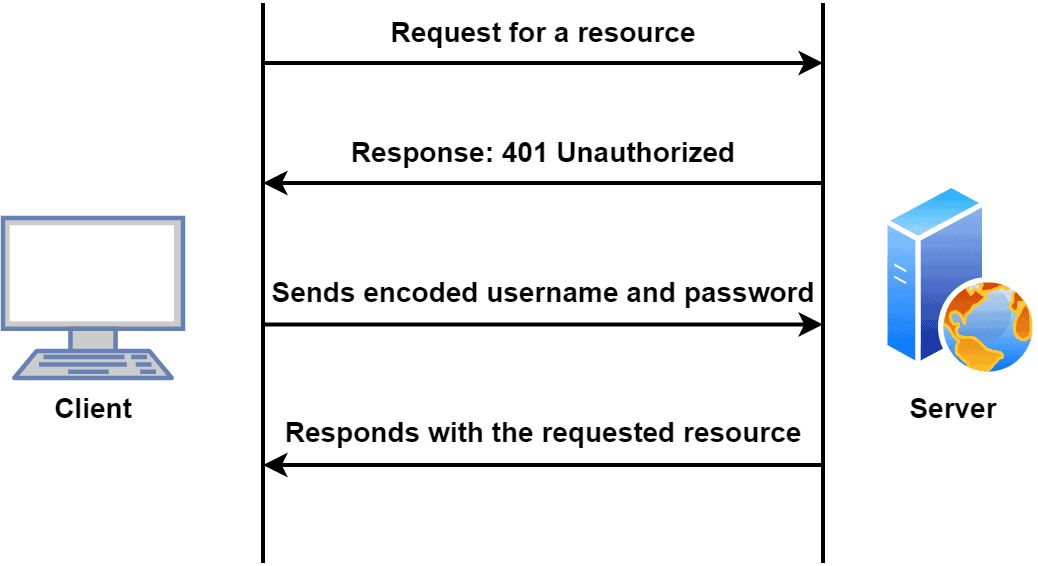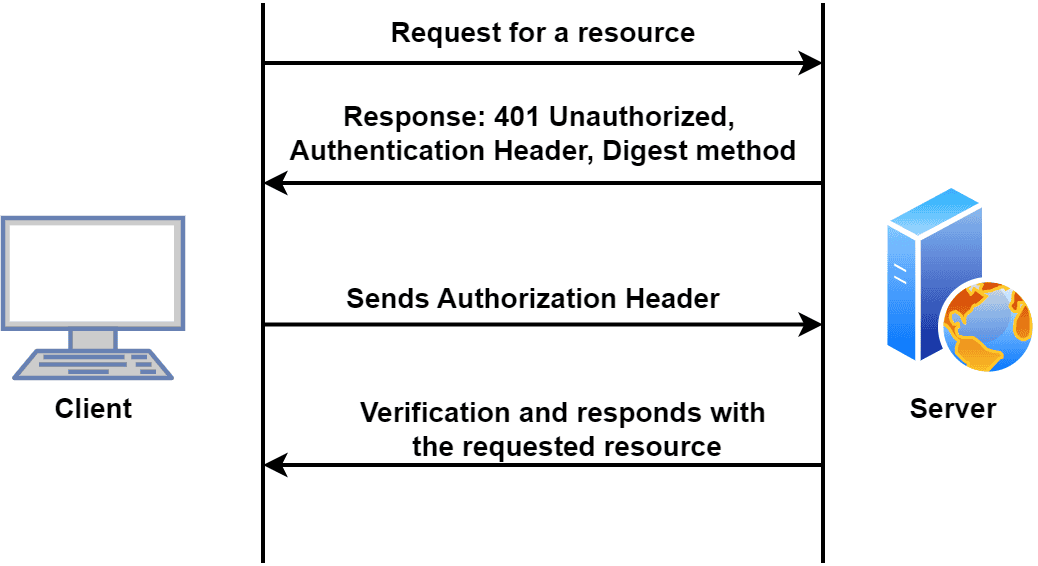1. Overview
In this tutorial, we’ll explore two authentication techniques: basic and digest.
Furthermore, we’ll present the main differences between them.
2. Introduction to Basic Authentication
Basic authentication is a simple authentication method that uses HTTP. Let’s take a look at the steps of the HTTP basic authentication process:
Let’s consider a scenario when a client requests to download a file from a server. The first step is to send a request to the server using HTTP. As soon as the server receives the request for a particular file, it responds in two ways. First, the server may grant the request and provide access to the file.
Alternatively, if the requested file requires authentication, the server responds with an HTTP status code. One such code is 401, which means unauthorized access.
When the client receives the status code, the user is asked to provide the username and password. Upon receiving the username and password from the user, the client encodes the information using the Base64 method. Finally, the client sends another request, including the encoded credentials.
Furthermore, upon receiving the encoded credentials, the server utilizes the Base64 method to decode the original credential. Moreover, the server verifies the decoded credentials with its dataset. After a successful verification, the server responds with the request file. On the other hand, if the verification isn’t successful, the server sends an HTTP status code.
2.1. Advantages
The main advantage of the basic authentication method is its simplicity. It’s easy to implement. Additionally, compatibility is another advantage, as most HTTP clients and web browsers support it.
Furthermore, the client sends the authentication information in a header file to the server. Therefore, the basic authentication methods don’t depend on cookies or sessions.
Finally, the server authenticates each request received from the server independently. Therefore, the authentication process is stateless. Hence, we need only one call to the server to access the requested file and authenticate it. As a result, the basic authentication method is faster than modern authentication methods.
2.2. Disadvantages
Now, let’s discuss some disadvantages of the basic authentication method.
It utilizes the Base64 method for encoding the credentials. However, the lack of encryption makes the credentials suspectable to cyber attacks such as replay attacks. Additionally, the basic authentication method doesn’t use a secure transmission channel. Therefore, cyber attackers can easily intercept and decode the credentials from the transmission channel.
Furthermore, the basic authentication method doesn’t support complex password policies, making it vulnerable to brute-force attacks.
3. Introduction to Digest Authentication
An alternative to the basic authentication method, the digest authentical method provides security while transmitting data. It contains the hashing technique to safeguard the credentials while transmitting. Additionally, it ensures the data integrity.
Now, let’s explore the steps in the digest authentication method:
First, the client requests to access a file from a server. The server sends a response with a status code 401, asking for the authentication. Additionally, it also sends an authentication header which contains several information:
- the name of the digest (hash) algorithm for calculating hash value
- a random number called the nonce
- the domain of the authentication, known as the realm
When the client receives the response from the server, it creates an authorization header containing the required information for authentication:
- username
- password
- nonce
- realm
- a Uniform Resource Identifier (URI) of the requested resource
- a hash value computed using the username, password, realm, nonce, URI using the method specified by the server
As soon as the server receives the authorization header from the client, it computes a hash value. If the hash value computed by the server matches the hash value sent from the client, the authentication is successful.
3.1. Advantages
The digest authentication method boosts the security of the data transmission compared to the basic authentication method. Here, we calculate the hash value from the credentials and transfer the value to the server. Hence, it not only ensures the integrity of the data but also protects it from replay attacks.
Furthermore, the digest authentication method facilitates mutual authentication. In mutual authentication, the client and server authenticate each other. Therefore, we can ensure both parties are genuine.
3.2. Disadvantages
One disadvantage of the digest authentication method is its complexity. The client and server need to implement the digest algorithm correctly. Additionally, as the digest algorithm runs on both the client and the server, it adds an overhead for communication.
Moreover, the digest authentication method uses HTTP for communication. HTTP is susceptible to cyber-attacks such as the man-in-the-middle (MITM) attack.
4. Differences
Now, let’s take a look at the main differences between the basic and digest authentication methods:
Basic Authentication
Digest Authentication
Implementation is simple
Implementation is complex
The requirement for computation resources is minimal
Needs more resources as both the client and server implement the digest algorithm
Minimal performance overhead
Higher performance overhead due to hashing
The authentication process is faster
The authentication process is slower
Doesn’t provide any encryption
Provides hashing to boost security
Credentials transferred as plain text
Credentials transferred as a hash value
Vulnerable to replay attacks
Provides protection against replay attacks
Only used in low-security applications
Used for applications that need more security
Less flexible in terms of session management
Provides better support for session management
5. Conclusion
In this article, we discussed two authentication techniques: basic and digest.
The basic authentication technique is easy to implement and fast. However, it’s vulnerable to cyber attacks as the credentials are transmitted as plain text without encryption.
On the other hand, the authentication technique enhances security by incorporating the digest method and sending a hash value instead of the credentials during communication.

